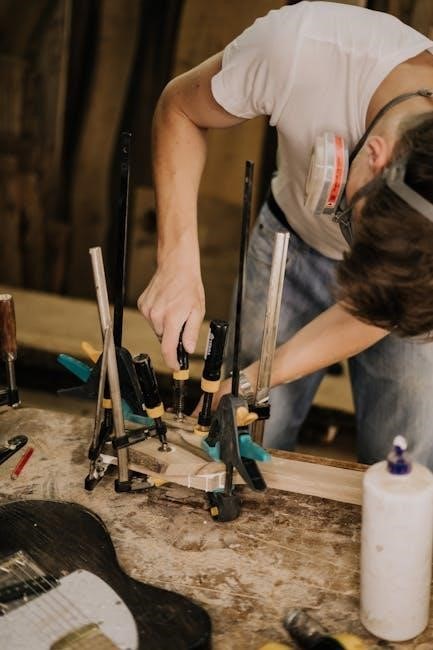Stock guides for table saws enhance cutting precision and safety by securely holding workpieces, reducing kickback risks, and ensuring smoother cuts. Essential for woodworking projects requiring accuracy.
1.1 What Are Stock Guides?
Stock guides are essential accessories for table saws designed to enhance control and safety during cutting. They consist of rollers and springs that securely hold the workpiece against the fence and table, minimizing kickback risks. These guides feature urethane tires on rollers mounted at an angle, providing consistent pressure and precise alignment. Unlike multiple featherboards, stock guides offer a streamlined solution for guiding material, ensuring smoother and safer cuts. They are compatible with various table saw fences, making them a versatile upgrade for woodworking projects;

Types of Stock Guides
Stock guides come in fixed and adjustable designs, catering to different woodworking needs and preferences for precise control and versatility in table saw operations.
2.1 Fixed vs. Adjustable Guides
Fixed stock guides offer stability and simplicity, ideal for standard cuts, while adjustable guides provide versatility for various materials and setups. Fixed guides are easy to install and maintain, suiting consistent workflows. Adjustable guides, like JessEm’s Clear-Cut TS, allow customization, enhancing precision and safety. They often feature angled rollers and urethane tires for better grip, reducing kickback risks. Adjustable guides adapt to different stock sizes and fence systems, making them a popular choice for woodworking projects requiring flexibility and superior control.
Installation and Setup
Installing stock guides is straightforward, with most models like JessEm’s Clear-Cut TS requiring minimal tools. Align the guides with your table saw’s fence for precise setup and optimal performance.
3.1 Step-by-Step Installation Process
Step 1: Unpack and prepare the stock guides, ensuring all components are included.
Step 2: Attach the guides to the table saw’s fence, aligning them with the T-slot for secure fastening.
Step 3: Tighten the mounting hardware firmly to prevent movement during operation.
Step 4: Adjust the guide arms to fit your specific table saw model, ensuring proper alignment.
Step 5: Test the setup by feeding a scrap piece of wood to ensure smooth operation and proper hold-down pressure.
Step 6: Fine-tune the guides as needed for optimal performance.

Safety Benefits
Stock guides significantly reduce kickback risks by securely holding workpieces, ensuring precise control and maintaining consistent pressure, thus enhancing overall safety during table saw operations.
4.1 How Stock Guides Prevent Kickback
Stock guides prevent kickback by securely holding workpieces against the fence, applying consistent pressure. Their angled rollers guide stock safely, minimizing lift and lateral movement during cuts, enhancing control and stability to reduce kickback risks effectively.
Materials and Construction
Stock guides are crafted from durable materials like urethane tires and robust steel, ensuring long-lasting performance and reliable operation, critical for precise and safe table saw use.
5;1 Importance of Durable Materials
Durable materials are crucial for stock guides to ensure reliability and longevity. High-quality components like urethane tires and robust steel constructions withstand heavy use, maintaining consistent performance. Urethane tires resist wear, ensuring a firm grip on the stock without marring the surface. Steel frames provide structural integrity, preventing bending or warping under pressure. These materials enhance safety by maintaining precise control during cuts, reducing the risk of kickback. Durable construction also minimizes maintenance, allowing woodworkers to focus on their craft without frequent replacements or adjustments, making it a worthwhile investment for both professionals and hobbyists.

Accessories and Compatibility
Accessories like Incra and Delta Unisaw compatibility kits expand the versatility of stock guides, ensuring seamless integration with various table saw fences for enhanced performance.
6.1 Popular Brands and Compatibility
Popular brands like JessEm offer high-quality stock guides designed for compatibility with various table saw fences, including Incra and Delta Unisaw models. These guides are engineered to fit seamlessly with T-slot tracks, ensuring versatility for different setups. Accessories like compatibility kits expand their functionality, making them suitable for a wide range of woodworking projects. Durable materials and precise engineering ensure enhanced safety and cut quality, while easy installation makes them a practical upgrade for any table saw. These products are trusted by professionals and hobbyists alike for their reliability and performance.

Troubleshooting Common Issues
Common issues include misalignment or worn rollers. Ensure guides are properly aligned and rollers are clean for optimal performance and safety during cutting operations.
7.1 Addressing Stock Guide Malfunctions
Stock guide malfunctions can hinder performance and safety. Common issues include misaligned rollers, worn urethane tires, or improper spring tension. To address these, recalibrate the guides, replace worn parts, and ensure proper tension. Regular cleaning and lubrication of moving components can prevent operational issues. If problems persist, consult the manufacturer’s manual or contact support for assistance. Proper maintenance ensures optimal functionality, safety, and precise cuts. Addressing malfunctions promptly prevents further complications and enhances overall woodworking efficiency.

Best Practices for Use
Always ensure proper setup, maintain guides, and use consistently for optimal performance. Regularly inspect and clean components to enhance safety and cutting accuracy in woodworking projects.
8.1 Maximizing Performance and Safety
For optimal results, ensure guides are properly installed and aligned with your table saw’s fence. Regularly inspect and clean the urethane rollers to maintain grip and accuracy. Always feed stock at a consistent rate, avoiding sudden movements that could cause kickback. The angled design of the guides naturally steers material toward the fence, enhancing control. Keep the guides lubricated to reduce friction and wear. By following these practices, you can achieve precise cuts while minimizing safety risks, making your woodworking projects more efficient and enjoyable.
Stock guides for table saws are essential for enhancing safety, precision, and control during woodworking. They prevent kickback and improve cut quality, making them a valuable addition to any workshop.
9.1 Final Thoughts on Stock Guides
Stock guides for table saws are an essential tool for woodworkers, enhancing safety, precision, and control. They prevent kickback and improve cut quality, making them indispensable for professionals and hobbyists alike. By securely holding material in place, stock guides ensure consistent results and reduce the risk of accidents. Their durable construction and ease of use make them a must-have for anyone looking to elevate their woodworking projects. Whether for rip cuts or intricate designs, stock guides are a reliable and valuable addition to any workshop, providing peace of mind and exceptional performance.

References
For more information, visit JessEm Tool Company’s website or Woodcraft.com. Additional resources include product reviews and user guides for stock guides.
10.1 Further Reading and Resources
For comprehensive insights, visit JessEm Tool Company’s official website or Woodcraft.com. Explore product reviews and user guides for detailed installation and usage tips. Additionally, The Wood Whisperer and Wood Talk podcast offer valuable insights into table saw safety and best practices. These resources provide in-depth information on stock guides, ensuring optimal performance and safety in woodworking projects.